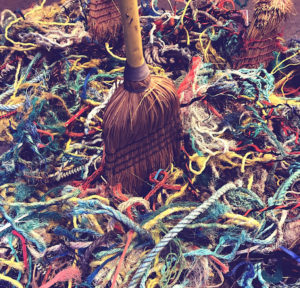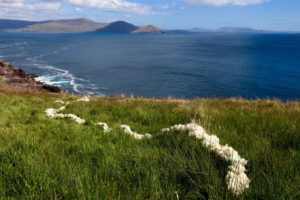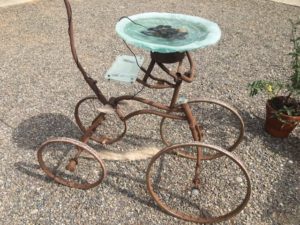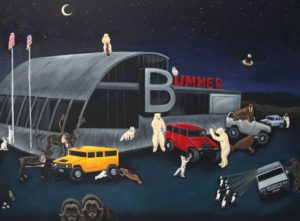YoloArts and Women Eco Artists Dialog (WEAD) present an exhibition of eco-art created by sixteen artists from Northern California and across the country. The featured works are curated from WEAD’s member artists and address significant environmental issues of our time.

Jo Hanson, sweeping the sidewalk in front of her house in San Francisco
This exhibition pays homage to the legacy of WEAD co-founder Jo Hanson, and the growing movement of artists who use their voices and creative actions to focus attention on issues of social and environmental concern. Co-founded in 1996 with fellow eco-artists Susan Leibovitz Steinman and Estelle Akamine, this volunteer-run non-profit provides information regarding environmental and social justice artists and genres, facilitates international networking among artists, and furthers the development and the understanding of environmental and social justice artworks.
Check out this Q&A from exhibit curators Janice Purnell, YoloArts creative director, and Nanette Wylde, WEAD board member.

How did you two connect for this exhibit?
Janice: Nanette was part of the California Society of Printmakers Exhibit at The Barn Gallery in 2019 and she shared with me her involvement with WEAD (Women Eco Artists Dialog). Of course, I was immediately intrigued and it sounded like exactly the type of collaboration that we wanted to bring to The Barn Gallery and to the Yolo community.
Nanette: When I first visited the Barn Gallery I was impressed with both the contemporary exhibition space and the locale, which is an interesting semi-rural, historical, and some might say, university suburb. I had recently joined the WEAD Board of Directors and was looking for exhibition venues new to the group. Janice was very welcoming to my initial inquiry. After several conversations we decided on a timeline and a curatorial strategy, which has been great fun to realize.

Why is Environmental Art important?
Janice: Environmental Art gives us a vantage point to both feel and perceive issues that affect all of us, which is the first step to building awareness and finding solutions. From this perspective environmental art promotes and compels personal and societal action. All of the artists in this show are sending out powerful personal messages about the environmental issues that concern them the most.
Nanette: Why is any art important? This is one of the most striking as well as befuddling questions of our times. The short of it is that one of the things that makes humans stand out from other species is the realization of our creativity and thought processes via making and transforming—thoughts into languages, communities into diverse cultural phenomena, the natural environment into built environments. Just look at what we have done to this planet in a very short time.
That which we call Art is among the strongest streams of human expression, i.e. communication. This often results in Art being misunderstood, resented and challenged. Historically, art which is valued most is art which speaks to an audience poignantly. In this current time of obviously experiential climate crisis, amidst science deniers at the highest levels of leadership, environmental art communicates lived and imagined realities. I think part of this genre’s impact is because humans are part of the environment, too, and some of us just need to be reminded of this as a fact. Art is good for that.

What kind of environmental artwork were you looking for specifically for this show?
Janice: Nanette and I wanted to make sure we selected works that represented a wide variety of themes and media. The work focuses on pressing environmental issues of our day including climate change, biodiversity and land preservation, to name a few. And the media is as varied as the subject matter from paintings and photographs to fiber art and 3D sculpture. It was also important to us to include outdoor installations created with both natural and manmade elements. We have two installations that can currently be viewed if you choose to take a walk through the grounds at the Gibson House and Property.
Nanette: We curated the exhibition from the WEAD Directory of Artists which is richly diverse, and in that, presented challenges of inclusion—there is just so much strong artwork being made in this genre. I think we both wanted to pull together a sophisticated offering which engaged viewers’ intellects and imaginations as well as being visually seductive. The artworks presented invite us to consider and question and discover. They don’t direct us as much as they enter into, arouse and entice us. That is their power.

What have you learned from this exhibit and what do you hope the viewers will learn?
Janice: First off, I am so grateful to Nanette for partnering on this exhibit and introducing me to this fascinating organization and eco-art genre. It is an honor to showcase the work of such an impressive group of accomplished artists. And personally, it has definitely inspired a shift in the way I see the world and interact with my own environment. I even made a point to purchase biodegradable plastic cups for our reception that we hope to have at the end of the summer. I hope that by viewing this exhibition the community gains even more sensitivity to the need for us to be better stewards of our environment.
Nanette: I very much enjoyed the collaborative curatorial process with Janice. We worked well together. Effective curation is very much about displaying works in a manner which optimizes the viewers’ experience, as well as develops a conversation amongst the works themselves. It’s a bit of a problem solving type puzzle. I also appreciated the opportunity to spend time with so much interesting art, the challenge of which works to include, the current result of experiencing the exhibition installed on site at YoloArts. For exhibition visitors, I hope they will take pause with at least one work and in that pause ask themselves, What is my part here?
Visit the Online Gallery to view images of each work of art and learn more about the exhibition.
Nanette Wylde is an interdisciplinary artist, writer and cultural worker making socially reflective and often language-based works using a variety of hybrid media. Wylde has a BA in Behavioral Science from San José State University. Her MFA is in Interactive Multimedia and Printmaking from Ohio State University. Her artists’ books, prints and electronic works are included in significant international collections. She is Professor Emerita of Art & Art History at California State University, Chico.
Janice Purnell, is YoloArts’ Creative Director and curator of YoloArts’ Gallery 625 and The Barn Gallery. She also manages the Art & Ag Project which connects artists and farmers through monthly farm visits and culminates in Art Farm, a signature event in Yolo County celebrating the visual arts and farmlands. She owned and operated a drawing school for children in Santa Monica and was artist-in-residence at North Davis Elementary, Davis. She has a BA from UC Berkeley where she studied art and art history. She also studied at Otis Parsons and UCLA Extension in Los Angeles.